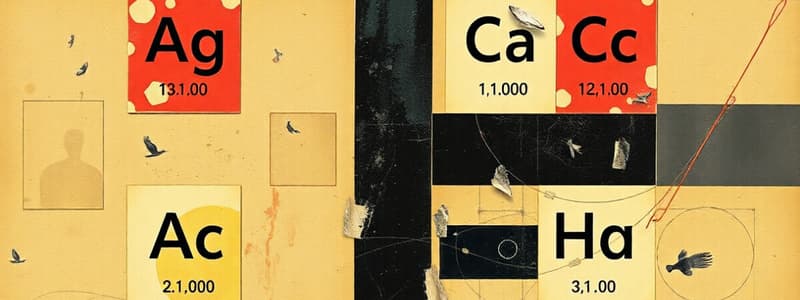Podcast
Questions and Answers
What is the electrostatic force of attraction between two oppositely charged ions called?
What is the electrostatic force of attraction between two oppositely charged ions called?
Ionic bond
Covalent bonds join metals to non-metals.
Covalent bonds join metals to non-metals.
False (B)
What type of bond joins metals to metals?
What type of bond joins metals to metals?
Metallic bond
In the following compound HH
H-C-C-H
HH
the symbol - represents [blank] pair(s) of electrons.
In the following compound HH H-C-C-H HH the symbol - represents [blank] pair(s) of electrons.
What is the correct formula for Sulfur Oxide?
What is the correct formula for Sulfur Oxide?
What is the chemical formula for Iron (III) sulfide?
What is the chemical formula for Iron (III) sulfide?
What is the chemical formula for Dinitrogen hexaflouride?
What is the chemical formula for Dinitrogen hexaflouride?
What is the number of valence electrons in the element Carbon?
What is the number of valence electrons in the element Carbon?
What is the molecular geometry of a molecule with no lone pairs?
What is the molecular geometry of a molecule with no lone pairs?
Flashcards
Ionic Bond
Ionic Bond
A chemical bond formed by the electrostatic attraction between oppositely charged ions, typically between a metal and a non-metal.
Covalent Bond
Covalent Bond
A chemical bond formed by the sharing of electron pairs between two non-metal atoms.
Metallic Bond
Metallic Bond
A chemical bond formed by the delocalized sharing of electrons between metal atoms.
Lewis Structure
Lewis Structure
Signup and view all the flashcards
Molecular Geometry
Molecular Geometry
Signup and view all the flashcards
Valence Electrons
Valence Electrons
Signup and view all the flashcards
Cation
Cation
Signup and view all the flashcards
Anion
Anion
Signup and view all the flashcards
Writing Chemical Formulas
Writing Chemical Formulas
Signup and view all the flashcards
Naming Ionic Compounds
Naming Ionic Compounds
Signup and view all the flashcards
Naming Covalent Compounds
Naming Covalent Compounds
Signup and view all the flashcards
Chemical Formula
Chemical Formula
Signup and view all the flashcards
Valence
Valence
Signup and view all the flashcards
Molecule
Molecule
Signup and view all the flashcards
Empirical Formula
Empirical Formula
Signup and view all the flashcards
Molecular Formula
Molecular Formula
Signup and view all the flashcards
Molecular Geometry
Molecular Geometry
Signup and view all the flashcards
Formula Unit
Formula Unit
Signup and view all the flashcards
Intermolecular Forces
Intermolecular Forces
Signup and view all the flashcards
Formula Unit
Formula Unit
Signup and view all the flashcards
Study Notes
Bond Types
- Ionic bonds: Form between metals and non-metals through electrostatic attraction between oppositely charged ions (cations and anions).
- Covalent bonds: Form between non-metals by sharing electrons. These bonds form molecules.
- Metallic bonds: Join metals to metals, characterized by a "sea of electrons."
Chemical Formulas
- Sulfur Oxide (III): SO₂
- Iron (III) sulfide: Fe₂S₃
- Dinitrogen hexafluoride: N₂F₆
Valence Electrons
- Valence electrons are electrons in the outermost shell of an atom.
- The number of valence electrons determines bonding properties and electron configuration of different elements.
Molecular Geometry
- Molecular geometry describes the three-dimensional arrangement of atoms and lone pairs in a molecule.
- The geometry is determined by the number of bond pairs and lone pairs around the central atom. This affects the shape.
- Examples of molecular geometries and angles include:
- Linear (180°)
- Trigonal planar (120°)
- Bent (<120°)
- Tetrahedral (109.5°)
- Trigonal pyramidal
- Bent
Studying That Suits You
Use AI to generate personalized quizzes and flashcards to suit your learning preferences.




